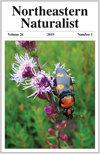DNA Metabarcoding-Based Evaluation of the Diet of Big Brown Bats (Eptesicus fuscus) in the Mid-Atlantic Region
IF 0.5
4区 环境科学与生态学
Q4 BIODIVERSITY CONSERVATION
引用次数: 1
Abstract
Abstract - High-throughput DNA sequencing can generate large genetic datasets in a cost-effective manner. Although the diet of Eptesicus fuscus (Big Brown Bat) has been studied widely in natural and rural systems using visual identification of prey items in feces, our aim was to more completely assess diet using a metabarcoding approach across a wide urban–natural landscape gradient in the mid-Atlantic region. Concordant with our expectations and previous Big Brown Bat diet studies from visual identification, we observed a high abundance of Coleoptera (beetles) relative to other insect orders. Although a possible improvement over visual techniques for studying food habits, we suggest caution in interpreting metabarcoding results in diet studies. We noted observations of environmental or contaminant taxa within these data, and designed a stringent filtering method that we used to eliminate these taxa, but that also removed previously documented prey taxa from our dataset.基于DNA代谢编码的大西洋中部大棕蝙蝠(Eptesicus fuscus)日粮评价
摘要-高通量DNA测序可以以经济高效的方式产生大量的遗传数据集。尽管已经在自然和农村系统中使用粪便中猎物的视觉识别技术对褐蝠的饮食进行了广泛的研究,但我们的目标是使用元条形码方法在大西洋中部地区广泛的城市-自然景观梯度中更全面地评估饮食。与我们的预期和先前的视觉识别大棕蝠饮食研究一致,我们观察到相对于其他昆虫目,鞘翅目(甲虫)的丰度很高。尽管研究饮食习惯的视觉技术可能有所改进,但我们建议在解释饮食研究中的元条形码结果时要谨慎。我们注意到这些数据中的环境或污染类群的观察结果,并设计了一种严格的过滤方法,我们使用它来消除这些类群,但也从我们的数据集中删除了先前记录的猎物类群。
本文章由计算机程序翻译,如有差异,请以英文原文为准。
求助全文
约1分钟内获得全文
求助全文
来源期刊

Northeastern Naturalist
环境科学-生态学
CiteScore
1.10
自引率
0.00%
发文量
42
审稿时长
18-36 weeks
期刊介绍:
The Northeastern Naturalist covers all aspects of the natural history sciences of terrestrial, freshwater, and marine organisms and the environments of the northeastern portion of North America, roughly bounded from Virginia to Missouri, north to Minnesota and Nunavut, east to Newfoundland, and south back to Virginia. Manuscripts based on field studies outside of this region that provide information on species within this region may be considered at the Editor’s discretion.
The journal welcomes manuscripts based on observations and research focused on the biology of terrestrial, freshwater, and marine organisms and communities as it relates to their life histories and their function within, use of, and adaptation to the environment and the habitats in which they are found, as well as on the ecology and conservation of species and habitats. Such studies may encompass measurements, surveys, and/or experiments in the field, under lab conditions, or utilizing museum and herbarium specimens. Subject areas include, but are not limited to, anatomy, behavior, biogeography, biology, conservation, evolution, ecology, genetics, parasitology, physiology, population biology, and taxonomy. Strict lab, modeling, and simulation studies on natural history aspects of the region, without any field component, will be considered for publication as long as the research has direct and clear significance to field naturalists and the manuscript discusses these implications.
 求助内容:
求助内容: 应助结果提醒方式:
应助结果提醒方式:


